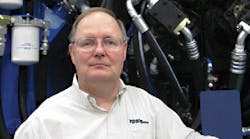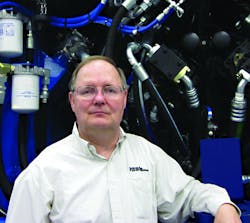Aside from these details, any positive-displacement pump will produce pressure ripple, which can cause vibration, speed variations, and other undesirable effects. Most system designers realize they won’t be able to eliminate pressure ripple altogether, so they decide how much they can live with.
However, Ellen Skow, graduate research assistant at Georgia Tech, has found that living with pressure ripple need not be all bad. She will be presenting a paper at next year’s IFPE Technical Conference explaining how capturing the peaks and valleys of pressure ripple can be used to generate electrical power. We’re not talking about a lot of power here, but enough to run wireless sensors for diagnostics, condition monitoring, and sensing beyond rotating joints, where wiring is problematic.
The title of Ms. Skow’s paper is “Pressure Ripple Energy Harvester Enabling Autonomous Sensing.” She explained, “Pressure ripple from pumps and actuators can reach as high as 10% of the mean pressure of the system. A hydraulic pressure energy harvester (HPEH) converts this pressure ripple into usable electricity for sensor nodes. The device contains a piezoelectric stack coupled with the pressure ripple in the system for energy transduction.”
This work is yet another innovative project made possible by funding from the Center for Compact and Efficient Fluid Power. The technical paper is scheduled to be presented Thursday, March 6, at 4:30 p.m. (To view the complete program of IFPE Technical sessions, visit bit.ly/1b0IXSj.) I don’t know about you, but I’ve already entered this date and time into my calendar.


